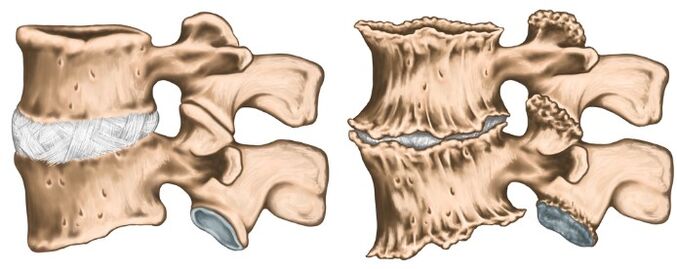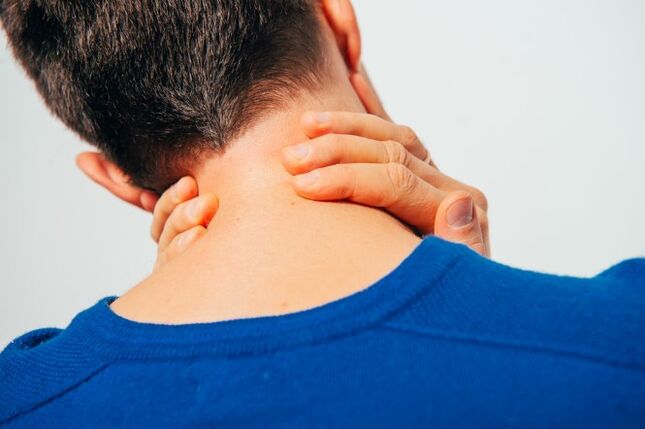With osteochondrosis of the spine, many of them are known not by popular gears on the television screen, but by their own sad experience.The statistics are harsh: up to 80% of the population suffers from this disease, which is also significantly more yard.If the worse complaints about the problems in the spine were mainly among the older generation, now childhood osteochondrosis is no longer surprising.And the guilt of a sedentary lifestyle and the so -read "benefits of civilization".

Osteochondrosis of the cervical spine is a polyethiological progressive disease that is manifested by degeneration of the intervertebral discs and dystrophy of the ligamental apparatus of the spine.Everyone knows about first -hand symptoms, but this knowledge is fragmentary;We will try to structure them, as well as to talk about the principles of diagnosis and treatment of osteochondrosis of the cervical spine.
The causes of osteochondrosis
Medical science cannot respond unequivocally, which is why osteochondrosis occurs.It is reliably known that the sedentary lifestyle that the modern man is inclined to adversely affect the progression of this disease.It is interesting that both hypodynamia and colossal loads from athletes lead to proxy on the discs.A hereditary factor plays a leading role.The following reasons are distinguished:
- burdensome hereditary history;
- obesity;
- Hypodinamia;
- metabolic disorders in the body;
- traumatic damage to the spine;
- Long static overloads and work related to weight lifting (computer work, weight lifting, miners, hammers, etc.);
- scoliosis;
- dysfunctional environmental situation;
- flat legs and pregnancy;
- Hypothermia and stress, which often cause exacerbation of the disease.
There are several neurological syndromes:
- shoulder -shoulder periarthritis;
- root;
- cardiac;
- Vail Arttery Syndrome.
Shoulder -Shoulder periarthritis.It is characterized by neck pain, shoulder, shoulder joint.The leading neurogenic contracture of the shoulder joint is formed, which is protective in nature as it protects the axillary nerve from stretching (antalgic posture).In this situation, the muscles around the joint are in tension.The severity of the pain syndrome depends on the degree of exacerbation of osteochondrosis: from a slight restriction on the amplitude of the movement in the joint to the so -called "frozen arm" when any movement causes severe pain.The pain intensifies when the shoulder is diverted and pronounced, as it is these movements that increase the tension of the axillary nerve.

Royshift Syndrome (cervical radiculitis).It is most commonly found with cervical osteochondrosis.At the same time, the spine of the spinal nerve is pressed due to the "lower" of the intervertebral discs, as well as the growth of osteophytes or the convexity of the discs in a lateral direction.The pain syndrome is specific: intense burning, rupture, pressing pain, which also increases when the patient moves his head.Antalgic posture is also noted in the muscles of the neck, they are sharply tense and painful, the volume of movements is limited.There is pain in the back of the head, neck, front breast, shoulder, between shoulder blades.It is characterized by interruption of sensitivity of the "short-sleeved semi-yake type" type.
Carden syndrome.The name of the syndrome is responsible for itself: the clinical picture is very similar to angina.In this case, there is no organic damage to the heart, in the height of the pain syndrome no disorders of coronary blood flow from the ECG are detected and such patients are well tolerated.Typical feature with angina pectoris: The pain occurs after nitrates are taken, and in the case of osteochondrosis does not change and worry for a long time.Unlike angina, the localization of pain is mainly in the heart on the left.With irritation of the roots of segments C8 - T1 are possible rhythm disturbances in the form of tachycardia and extrasystole.This is not due to damage to the conducting system of the heart, but with a violation of the sympathetic innervation of the heart muscle (damage to the extracardia).With the differential diagnosis of angina and cardiac syndrome, the leading is the fact that, in addition to cardiac complaints, the patient notes an increase in pain in the shoulder joint and the neck associated with lifting or severe movements.
Vail Arttery Syndrome.The pelvic artery is carried out in a channel formed by holes in the transverse processes of the vertebrae.This artery is paired, it is responsible for the blood supply to the brain.Accordingly, any narrowing of this canal very negatively affects the nutrition of brain tissue.Spinal artery syndrome develops directly both with compression of the artery itself and with irritation of the sympathetic nerve plexus located around it.The pain in this pathology burns or throbs in the back with whiskey, lessons, crows.It arises from both sides.Patients usually associate aggravation with after sleep in non -physical posture, transport travel, walking.With pronounced symptoms, hearing loss, dizziness, tinnitus, nausea, vomiting, loss of consciousness and increase in blood pressure.Such symptoms are not specific and are very similar to stroke complaints.This pathology is characterized by the syndrome of the Sistine Chapel: a seizure that occurs when you turn your head back (severe brain ischemia).He was described by visitors to the Sistine Chapel in the Vatican when they examined the murals in her arches.It may also fall without losing consciousness with sharp turns of the head.
Like any diagnosis in medicine, the diagnosis of osteochondrosis is found on the basis of patient complaints, a history of the disease, clinical examination and methods of ancillary tests.X -ray cervical spine in direct and lateral projections, if necessary in special positions (with mouth open).At the same time, experts are interested in the height of the intervertebral discs, the presence of osteophytes.Modern research methods use IAMR and CT tests that do the diagnosis as accurately as possible.In addition to the following methods of additional research, consultations of related specialists (cardiologist, ophthalmologist, neurosurgeon) may be needed, and the neurologist's examination is simply vital.The neurologist is involved in the treatment of osteochondrosis, so after examining the patient, he will prescribe the necessary minimum examination at his discretion.

Treatment of osteochondrosis
Osteochondrosis is a polyetiological disease because a course of therapy is not cured.You can't drink a "magic pill" and everything will pass, it is necessary to change your lifestyle mainly, since the trigger is hypodynamia.The most tangible results are easier to achieve in the early stages of the disease, when the complaints are minimal and there are no compression syndromes and spinal artery.In the acute stage of the disease, when the following drug groups are pronounced: Pain syndrome is pronounced:
- Therapeutic paravertebral blockade (to relieve pain and eliminate muscle spasm);
- NSAIDs;
- Layers containing NSAIDs and reflective action;
- muscle relaxants;
- In vitamins V.
As the inflammatory process also disappears the relief of pain syndrome, they move on to physiotherapy treatment.The following techniques are most commonly used:
- laser therapy;
- electrophoresis;
- acupuncture;
- Exercise therapy;
- therapeutic massage;
- Manual therapy.
It is important to understand that osteochondrosis continues with periods of exacerbation and remission, therefore it is very important to affect the cause and not to treat the investigation.































